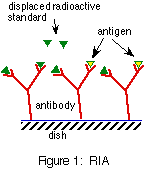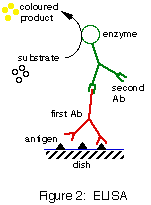ELISA - an important clinical analytical technique: Theory
5.1 Introduction
The aims of this practical are:
5.2 Theory and background
By now you should appreciate the use of chromogenic reactions for the detection and quantitative determination of molecules of clinical importance. The simple procedures you have seen that involve the direct or indirect determination of some property of the material of interest (e.g. enzyme activity, or size) are limited in terms of sensitivity (OK for mM or perhaps µM), specificity (ISE membranes may allow the passage of more than one ion, or a chromogenic substrate may be acted upon by more than one enzyme) and generality of use (the material of interest must have some measurable property — not always the case).
It would be ideal if you could have a technique that was extremely sensitive (nM or less), was totally specific for the compound you wished to measure, and could be adapted to measure virtually anything i.e. a method that detected merely the presence of something and not a property. This is where antibodies are extremely useful.
Antibodies
A complete description of antibody synthesis, structure and function is beyond the scope of this introduction. You should refer to any standard text book for further information, for example Chapter 14 of "Biochemistry" by L. Stryer (4th edition, Freeman).
Antibodies are proteins synthesised and secreted by B lymphocytes in response to the presence of an antigen in the blood. The antigen is usually a "foreign" protein, e.g. a bacterial or viral surface protein. Antibodies belong to the immunoglobulin class of proteins and there are various subtypes (e.g. IgG, IgM). They have a Y-shaped structure (see Figures below). The important thing about them from the practical point of view is that they are designed to fit the antigen like a key fits a lock in the same way that enzymes and their substrates have a high specificity for each other. However, the specificity and affinity of an antibody for an antigen is often much higher than that of an enzyme for its substrate. Thus, the perfect antibody "anti-X" will recognize and bind very tightly to compound "X" but will not touch compound Y, even though X and Y might be quite similar.
Since antibodies are proteins, if you inject an IgG from one species (e.g. rabbit) into another species (e.g. goat, therefore "non-self"), you will get an antibody to the antibody (goat anti-rabbit IgG). The practical importance of this will become evident below. You will now see that we ought to be able to use antibodies to detect specific antigens with high sensitivity and specificity.
The immune system normally only makes antibodies to large molecules such as proteins. However you can fool it into making an antibody to a small molecule by first attaching the small molecule to a "non-immunogenic" protein, i.e. a protein that does not stimulate the production of an antibody against itself (they do exist). This is also useful (see below).
Radioimmunoassay (RIA)
 One application of antibodies (Abs) that is particularly suited to the measurement of compounds of low molecular weight is the radioimmunoassay. This method requires you to have a radioactive standard of the compound you wish to measure e.g. [3H]oestradiol or [125I]thyroxine. At its simplest, the control assay contains e.g. [3H]oestradiol plus an anti-oestradiol Ab which bind tightly to each other. When a coagulant is added to precipitate the protein (Abs are proteins) all the radioactivity is also precipitated. The test assay contains [3H]oestradiol, anti-oestradiol Ab and the sample with the unknown amount of oestradiol. The oestradiol in the sample displaces some of the radioactive oestradiol from the Ab (they have the same affinity for the Ab) so when the coagulant is added some radioactivity remains unprecipitated. This can be separated by centrifugation and measured. The amount of radioactive oestradiol released is equal to the amount of non-radioactive oestradiol in the sample.
One application of antibodies (Abs) that is particularly suited to the measurement of compounds of low molecular weight is the radioimmunoassay. This method requires you to have a radioactive standard of the compound you wish to measure e.g. [3H]oestradiol or [125I]thyroxine. At its simplest, the control assay contains e.g. [3H]oestradiol plus an anti-oestradiol Ab which bind tightly to each other. When a coagulant is added to precipitate the protein (Abs are proteins) all the radioactivity is also precipitated. The test assay contains [3H]oestradiol, anti-oestradiol Ab and the sample with the unknown amount of oestradiol. The oestradiol in the sample displaces some of the radioactive oestradiol from the Ab (they have the same affinity for the Ab) so when the coagulant is added some radioactivity remains unprecipitated. This can be separated by centrifugation and measured. The amount of radioactive oestradiol released is equal to the amount of non-radioactive oestradiol in the sample.
In a variation of the method (Figure 1), the Ab is "immobilised" (attached) to the base of a small well in a plastic dish, or "multiwell plate" (certain plastics bind proteins very tightly so this is easy). In the control assay, when radioactive oestradiol is added to the well it all sticks to the Ab and so is "sucked" out of solution. Any non-radioactive oestradiol in the test sample reduces the amount of radioactive oestradiol removed from solution and again this can be measured and compared to the control.
Enzyme-linked immunosorbent assay (ELISA)
 The ELISA is ideally suited to assaying protein factors e.g. insulin or luteinising hormone (LH) but can be adapted to measure small molecules as well. There are several variations of the method. For example, the protein factor (test sample, e.g. containing LH) is first immobilised on the bottom of a multiwell plate well (Figure 2) and then any remaining binding capacity the plastic well has for protein is swamped ("blocked") by some non-interfering protein e.g. albumin. Next the "first antibody", e.g. anti-LH, is added. The amount of this that sticks in the well depends only on the amount of LH already there (the well having been blocked). A "second antibody" is then added which recognises and binds to the first antibody (typically the first antibody will be of the IgG class raised in a rabbit or a mouse and the second antibody will be raised by injecting another animal (e.g. a goat) with rabbit or mouse IgG to produce e.g. goat anti-rabbit IgG. This second antibody will already have been covalently attached ("conjugated") to an enzyme such as alkaline phosphatase or peroxidase which can catalyse a chromogenic reaction. When the colour reagents are added, the amount of colour that develops depends on the amount of enzyme, which ultimately depends on the amount of LH originally immobilised from the unknown sample – high LH, high colour development.
The ELISA is ideally suited to assaying protein factors e.g. insulin or luteinising hormone (LH) but can be adapted to measure small molecules as well. There are several variations of the method. For example, the protein factor (test sample, e.g. containing LH) is first immobilised on the bottom of a multiwell plate well (Figure 2) and then any remaining binding capacity the plastic well has for protein is swamped ("blocked") by some non-interfering protein e.g. albumin. Next the "first antibody", e.g. anti-LH, is added. The amount of this that sticks in the well depends only on the amount of LH already there (the well having been blocked). A "second antibody" is then added which recognises and binds to the first antibody (typically the first antibody will be of the IgG class raised in a rabbit or a mouse and the second antibody will be raised by injecting another animal (e.g. a goat) with rabbit or mouse IgG to produce e.g. goat anti-rabbit IgG. This second antibody will already have been covalently attached ("conjugated") to an enzyme such as alkaline phosphatase or peroxidase which can catalyse a chromogenic reaction. When the colour reagents are added, the amount of colour that develops depends on the amount of enzyme, which ultimately depends on the amount of LH originally immobilised from the unknown sample – high LH, high colour development.
A variant of this which you will use today, (competitive ELISA), combines the strategies of RIA and ELISA and can be used to measure small, non-protein molecules which by themselves do not bind to plastic dishes. The small molecule standard, e.g. cotinine, is first covalently attached to an inactive protein carrier that allows it to bind to the plastic. The first antibody (e.g. rabbit anti-cotinine) is added in the presence of the sample containing the unknown amount of cotinine. The unknown (free in solution) competes for binding to the first antibody and so reduces the amount of first antibody that binds to the well and, therefore, the extent of the final colour reaction — the more cotinine in the sample, the less the colour that eventually develops.
Cotinine
Cigarette smoking is a major contributory factor in cancer and in lung, cardiovascular and periodontal disease. In order to correlate disease progression with tobacco use, it is necessary to have a reliable quantitative marker. Nicotine is the major alkaloid in tobacco but has a half-life in plasma of only 30 min, so cannot readily be used as a biochemical marker of tobacco use. Nicotine is rapidly converted in the body to the much more stable metabolite cotinine, which has a half-life of between 10 and 30 h, so its level remains relatively constant in active smokers over long periods of time. It is therefore used to monitor smoking behaviour and smoking status in both active and passive smokers. A typical serum cotinine level in smokers is around 450 µg/l, while in non-smokers it can be up to 20 µg/l due to passive smoking. These are low levels so a sensitive assay is required.
In this practical, you will use a competitive ELISA to measure cotinine levels in the serum of smokers, non-smokers (unexposed), and passive smokers who live with smokers.
Standard cotinine is first immobilised in the wells of a multiwell plate by covalently linking it to a synthetic protein (polylysine) that binds very tightly to the plastic. After blocking, a rabbit anti-cotinine Ab is added to the wells along with a diluted serum sample and a series of cotinine standards of known concentration. The amount of this "first Ab" that binds to the immobilized cotinine in the well is inversely proportional to the amount of competing cotinine in the serum. The amount of bound first Ab is then determined by the addition of peroxidase-conjugated goat anti-rabbit IgG followed by a colorimetric assay for peroxidase enzyme activity after washing out all unbound material from the wells. Hence, a low level of peroxidase activity in the well means a high level of cotinine in the added serum.